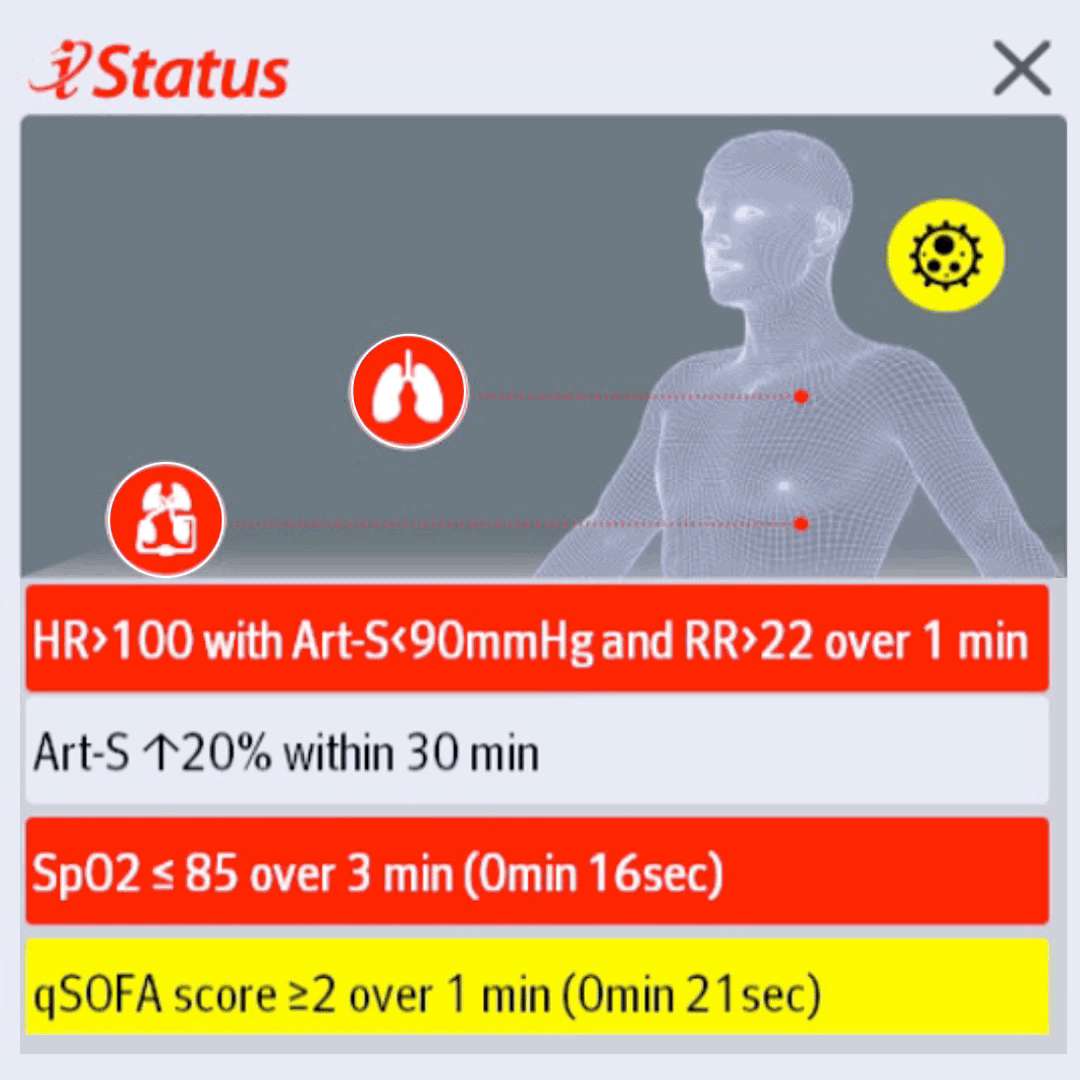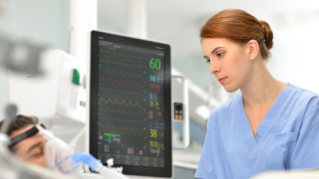Finding an Intelligent Way Out of the Challenging Alarm Hazards
Mindray’s proprietary alarm management solution for the critically ill

Continuous patient monitoring and alarming through various high-acuity devices at the bedside makes it possible for clinicians to identify deterioration signals as early as possible. Alarms are designed to be highly sensitive to ensure no important events are missed. However, when it comes to real-life ICU scenarios, a large number of screening sounds and visual alerts surrounding beds and nurse stations are leading to another critical challenge - alarm fatigue.

Defined by the American Association of Critical Care Nurses as a sensory overload that occurs when clinicians are exposed to an excessive number of alarms, alarm fatigue is a growing and widespread concern in healthcare. Studies have found that around 80 ~ 99% of all reported alarms are false or nonactionable, which in turn exacerbate feelings of stress, overload, and insecurity. [1][2][3] Over time, clinicians will get desensitized to alarms, thus resulting in serious clinical consequences, such as increased rates of missed alarms or delayed responses.
The rapidly evolving data processing and analysis technology has unlocked new possibilities of building more intelligent alarm management solutions. Leveraging its years of know-how and expertise in alarm technologies and strategies, Mindray has launched the iAlarm alarm management solution. It works intelligently through an efficient workflow, redefining the way alarms are handled in every step from identification, reporting, and distribution through to management and analysis.


Prof. Elie Azoulay
President of the European Society of Intensive Care Medicine
It's not something that is burdening at the time of making the noise. It is something that is burdening over time and it adds to many other sources of burden, creating discomfort for patients, harm for family members, and a lot of workload for healthcare providers.
Combine the Powers:
Parameters Speak of Each Other
Traditionally, the parameters representing various physiological states have been collected independently for monitoring and alarming. This gives rise to repeated alerts and inconsistent alarm settings, which are a significant source of alarm hazards. However, it is possible to turn the large amount of data collected this way, if processed and managed properly, from a burden into a valuable resource.
Mindray's latest signal analysis technologies combine multiple signals together for interference and noise identification. As disturbances or adjustments in localized areas affect only a single signal, distinguishing them from the actual physiological changes of the human body can effectively reduce false positives and maximize alarm accuracy. The patented CrozFusion™ technology uses a unique algorithm to recognize the strengths of different signals and categorizes them by the strength (SQI: Signal Quality Index), thereby suppressing false alarms caused by signal noise. By cross-checking multiple parameters to ensure that only real abnormalities will be flagged out, the technology helps to reduce related false alarms by nearly 50%. Dedicated IBP Interference Identification Technology focuses on the high-sensitive IBP signals and detects true fatal alarms by using ECG and SpO2 waveforms as reference.
False Alarm Suppression Performance

Personalize the Settings:
Enhanced Intelligence for Each Individual
Proper alarm settings can significantly reduce the frequency of false or insignificant alerts. Given the varying patient conditions and monitoring requirements between departments and individuals, a single standardized alarm setting that simply filters out meaningless signals may be insufficient to pinpoint those that require additional attention.
Mindray provides intelligent alarm limit recommendations and a back-off mechanism based on the trend data over a period of time to support personalized threshold settings for different patients. If an adjustment is identified, caregivers will be notified by the system with an intuitive view of the trend data and suggested threshold. They can either accept or reject the suggestion with a single click or adjust the threshold based on their own clinical experience. The system also enables the department to set separate Guard Limits, avoiding overextended alarm thresholds for specific patient category that could undermine the detection of patient deterioration, and helping to achieve more balanced patient safety.

Alarm Limits Recommendation
Capture Patient Deterioration:
Understand a Condition Change Comprehensively
When receiving a traditional alarm triggered by single-parameter changes, clinicians often need to perform a few more procedures to evaluate the vital signs and their trend data over time to identify the condition change and its severity. So, is there any way to get this multi-step evaluation done automatically with a monitoring system so as to produce more instructive and accurate alarms?
With this in mind, Mindray's new “Status Alarm” redefines abnormalities in a more comprehensive manner, taking into account the relationship between interrelated parameters and that between the time spectrum and the scale of change. With the ability to analyze the real-time status, trend and abnormality duration of multiple parameters, the new solution provides 14 preset status alarms covering 5 most concerned physiological systems - circulatory system, nervous system, respiratory system, cardiac and infection, and supports customization for effective early warning of patient deterioration.

For clinicians to take prompt and appropriate actions and interventions, it is also essential to present intuitive alarms that are easily understandable for clinicians. Mindray's alarm notification features bright color tags and graphical illustrations of the physiological systems to clearly indicate the patient's status, sending salient messages from the distance and pointing out the direction to go to speed up diagnosis.
Maximize the Efficiency:
Respond Within the Alarm Management Network
The development of a silent ICU to create a more healing and relaxing environment has long been hindered with the intensive alarms that have deleterious effects on patients' sleep, stress levels and thereby recovery times. As part of the effort to lower alarm sounds in ICUs, digitalization and connectivity technologies can be used to open up new potentials to ensure effective and responsive distribution and management of alarms.

Dr. Fiona Niu
Global Marketing Director of PMLS, Mindray
As healthcare technology continues to evolve, it is also important to think beyond basic patient life support to provide higher-quality care. The overloaded alarm noises at the bedside prevents patients from sound sleep and rest, which presents an urgent challenge to the overall recovery. We believe that advancing the alarm identification and distribution system to secure a silent ICU environment is undoubtedly indispensable to the future development of critical care.
Mindray's AlarmGUARD solution, classified as a CDAS (Distributed Alarm System with operator Confirmation), allows caregivers to be assigned to specific patients in central stations, view stations, or via mobile devices for a complete alarm management network. If the designated caregiver fails to respond properly, the alert will be routed to the predefined colleagues based on the customized settings, ensuring caregivers are fully aware of and respond promptly to patient deterioration.
To prioritize the meaningful alarms and prevent them from being flooded with subsequent notifications, the system is also equipped with a smart alarm escalation strategy - a higher priority will be given after a certain period of time if the alarmed condition has not been resolved or certain alarms occur at the same time. AlarmGUARD helps clinicians handle alarms as efficiently as possible by allowing them to receive notifications and check patients' real-time monitoring parameters, waveforms, infusion information, trends and 12-lead ECG report anytime while moving around their facility.





Medical technology today offers more potential for smarter information processing and decision-making recommendations than simple problem identification. Alarms, instead of being treated as singular events, are critical resources for optimizing patient monitoring and department management processes.
With technological innovations to bring more accurate alarm identification and efficient alarm distribution, Mindray's iAlarm solution also offers a comprehensive alarm analysis tool to systemically analyze the alarm data of bedside equipment and thus pinpoint the adjustment needed for further reducing the occurrence of clinically insignificant alerts. This intelligent close-loop alarm chain management solution offers substantial assistance for clinicians to continually advance more supportive and preventive patient care. It is also in this way that the ultimate value of technological advances can be brought into full play - to take on repetitive and time-consuming tasks so that clinicians can be more focused on their patients.
Reference:
[1] Lawless ST. Crying Wolf: False Alarms in a Pediatric Intensive Care Unit. Critical Care Medicine. 1994; 22: 981– 985.
[2] Tsien C, Fackler J. Poor Prognosis of Existing Monitors in the Intensive Care Unit. Critical Care Medicine. 1997; 25( 4): 614– 19.
[3] Chambrin MC, Ravaux P, Calvelo-Aros D, Jaborska A, Chopin C, Boniface B. Multicentric Study of Monitoring Alarms in the Adult Intensive Care Unit: a Descriptive Analysis. Intensive Care Med. 1999; 25: 1360– 66.










